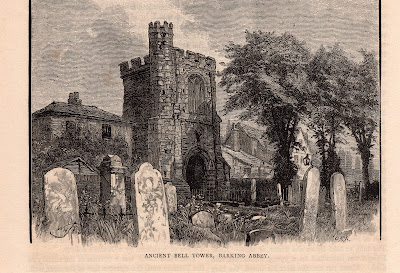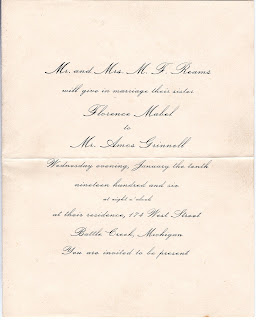 |
| Barking Abbey, Barking, Essex, England where the Burling family resided. |
Several years ago I wrote about the discovery of Mary
Elizabeth (BURLING) REAMS’ (b1845-d1918) ancestry. It was a huge revelation because I had spent
years working hard to discover the names of her parents, both of whom died
while she was yet a baby. At the time, I
was so overwhelmed by the facts of so many new generations to record in my
genealogical software that I could scarcely absorb the significant family
history connected with Mary.
Mary’s BURLING ancestors were Quakers in England and in North America and they had strength of spirit.
Mary (BURLING)
REAMS (1845-1918), daughter of:
Henry BURLING
(1803-1848) and Charlotte Wilburgher WILSIE (1812-1845), he was the son of:
Ebenezer
BURLING(1766-1824) and Eve BLOOMER (1765-1843), he was the son of:
Ebenezer
Slocum BURLING (1741-1831) and Kezia HUNT (1742-1804), he was the son of:
Ebenezer
BURLING (1717-1758) and Mary LAWRENCE (1718-aft 1776), he was the son of:
*William
BURLING (1678-1743) and Rebecca SLOCUM (1682-1729), he was the son of:
*Edward
BURLING (1638-1697) and *Grace NORINGTON (?-1715) , he was the son of:
Edward
BURLING (c1613-1677) and Katherine BOWLER (?-1678) of Barking, Essex Co.,
England
*denotes the ancestors who emigrated from England to North
America.
We learn from the amazing thorough and well sourced
genealogy and family history by Jane Thompson-Stahr (The Burling Books, Vol, 1 & 2, 2001), that the first three
generations of Burling’s were members of the Quaker faith and practiced it at a
time of religious intolerance in England.
In fact, both generations of Edward BURLING’s were imprisoned for
practicing their faith. Neither of which
would pay the fine, though they were presumably wealthy enough to do so, and be
freed from their jail cells. They stood
on their principles in the Borough of Barking, which is now part of the City of
London. Clearly that principled streak
was inherited by son and grandson William.
We have learned from no less than four sources on Quaker history that
William BURLING of Flushing, NY was an early member of the Friends faith to
embrace the view that slavery was a sin.
During much of the 17th and 18th century in
Colonial America, Quakers were known to be slave holders and slave traders in
New England and the Mid-Atlantic. Many
today find this surprising because of the popular notion that Quakers were some
of the most outspoken advocates of abolitionism in the antebellum period;
therefore it’s somewhat hard to believe that they were ever involved in the
holding of others in bondage. But many did!
About 1718, William BURLING spoke out against the sin of
slavery. His words are somewhat
difficult for our 21st century reading, but I have confirmed through
multiple sources that indeed, William BURLING was talking about slavery when he
wrote the following, which had reprinted in several book since 1734.
(William Burling’s Anti-slavery text, published in 1718 and
quote in Benjamin Lay’s 1738 book.)
TITLE: “An Address to
the Elders of the Church, upon the occasion of some Friends compelling certain
Persons, and their posterity , to serve them continually and arbitrarily,
without Regard to Equity or Right, not heeding whether they give them any thing
near so much as their Labour deserveth.”
My Dearly Beloved
Friends, and Elder Brethren, whom, as it behoves me, I would entreat as Fathers,
a weighty Concern from the Lord, is and hath been at times for many Years on my
spirit, in consideration of this unchristian Liberty, being indulged in the
Church, for it is in itself none of the least of the World’s Corruptions, [
no, say I, but the greatest, that ever the Devil brought into the Church in
America;] and indeed the Lord by his Spirit,
manifested the Evil to me before I was 12 Years of Age, and since from time to
time, I have had drawings in mind to reproved and testify against it, nor have I been altogether silent, altho’
much discourag’d by reason of it’s being practiced by so many Friends, yea
Elders too, and tho’ I have formerly thought it strange, that the Church did
not exclude it, by her discipline, and fix the Judgment of Truth upon it, yet
now I am sensible such a thing is not easily done or accomplished, there being
so strong opposition in many, that it cannot be brought to the Test, and
Judgment brought forth into Victory in the cause at present, without danger of
much strife and disorder in the Church, which is generally hurtful where-ever
it prevaileth; therefore to be carefully avoided; however I hope was are all
unanimous in our judgement, that whatever Friend hath any thing from the
movings of the Spirit of Truth to communicate to his Brethren, either by word
or writing concerning this or any other matter, ought to be allowed and
received in his Testimony, and borne with by his Brethren, so long as he keeps
to the counsel and direction of the Holy Spirit, and therefore delivers nothing
but what is according to Truth, altho’ it happens to be never so contrary to
the interest or inclinations of the Readers or Hearers.
Now I would such
Friends as Practice or Pleas for the abovesaid Sin, Evil or Liberty, to
consider solidly what Hardship the impose on such as are concern’d to bear
Testimony against it; for while so many Friends continues in said Practice, no
one can reproved it, and give it that deserved Character, which is agreeable to
it’s nature, without implicitly condemning many of his Brethren, [Ministers
and all say I, for they are the worst Enemies in this case the Church has to
War with, or that Hell itself, or Devil can procure in this case. (This is very
pinching, B. L. canst thou prove thy Allegations?) if not,
what will become of thee? Never fear, Friend; Fear suprises, thou knows who;
but the Truth is stronger than all the Powers of Hell. Blessed for ever is the God of Truth, the
Truth of God, the Truth which is God: So be it, faith my Soul.
Brethren and Elder Brethren,
as Transgressors in this Thing, which is very hard to do, yet if the Lord
require such a Thing or Testimony of any Friend he is necessitated so to judge
his Brethren, or quench the Spirit in its Motions, in his own Heart; for the
case admits of no medium. Again I intreat those who slight and disregards the
Testimony of any whom the Lord concerns to appear against this flebly Liberty,
to consider whom they oppose, and withstand; and the inspired Apostle speaking
concerning the Lord’s Instruments, whom he was pleased to make use of, faith I
Thess. iv. 8. He therefore that
despiseth, despiseth not Men, but God, who hat also given unto us his Holy
Spirit. O! That I could prevail so far
with all my dear Brethren, that none would any more plead for or endeavor to
defend the aforesaid unjust Practice; neither endeavor to shield it from the
judgment of Truth. We may do well to
remember, the Devil is the Author of all Sin, and Sin is the Transgression of
the Law.
It gives me great pleasure to know that at least one of my
ancestors was outspoken on such a moral and ethical issue, especially when it
was not popular to hold such a position.
So, today in our world that is filled with much divisiveness over our
national legacy concerning race relations, I draw on the strength of my
ancestor, William Burling to help guide me.
Sources:
-Drake, Thomas E. Quakers
and Slavery in America, 1950, pp.36-37
-“Early Anti-Slavery Advocates -- William Burling.” The Friend: A Religious and Literary Journals, November 24, 1855,
Volume 29, Number 11, page 85.
-Lay, Benjamin. All Slave-keepers that keep the Innocent in
Bondage… Philadelphia: Benjamin Franklin, 1738, pp. 6-8.
-Maxwell, John Francis.
“The Charismatic Origins of the Christian Anti-Slavery Movement in North
America, “ Quaker History, Volume 63,
Number 2, Autumn 1974, pp. 108-116.
-Thompson-Stahr, Jane. The
Burling Books, 2001
 |
| A popular 19th Century Anti-Slavery image. |









